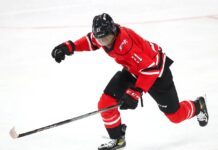The Maple Leafs have acquired help for their top-nine forward group, adding Oakville native Scott Laughton along with fourth-round and sixth-round picks from the Philadelphia Flyers in exchange for Toronto’s first-round draft pick in 2027 (top-10 protected) and prospect Nikita Grebenkin. The Flyers have retained 50% of Laughton’s $3 million AAV contract, which extends through the end of next season.
It was a long-rumoured trade, and the Leafs paid up to some extent to get it done. It’s a lot to give up at first blush, but that’s the NHL trade market at this deadline, and Scott Laughton at just $1.5 million through the end of next season is excellent value, as is fetching some additional draft picks for flexibility (in addition to keeping their 2026 first).
I wrote about Laughton last month:
Scott Laughton’s name has come up for well over a year now as a prototypical 3C option for the Leafs, and it resurfaced again when he scored against the Leafs a few weeks ago in their home-and-home series.
Also noticeable in those games: Laughton didn’t actually play center. In fact, his head coach, John Tortorella, is on record stating he prefers him on the wing. If we consider Laughton more of a winger than a center, it really changes the calculation.
Laughton’s jam and defensive play are brought up a lot, but I actually like Laughton because he’s a good secondary scorer and the Leafs need more scoring depth. In his last two seasons, Laughton has tallied 43 points in 78 games, followed by 39 in 80. He’s already at 23 (nine goals) in 47 games this season. He’d rank seventh among Leafs forwards in goals, and at his $3M cap hit, it’s a sensible fit all-around.
Laughton is a legitimate .5 point per game player, and this is a team that’s regularly run out Pontus Holmberg, Max Domi, and Nick Robertson, among others, on its third line. Laughton is pacing to outproduce all of them, and the Leafs have lacked secondary scoring in every playoff. Laughton would assist them in this department.
Laughton also *can* play center. My argument isn’t that he can’t play in the middle at all. Much like Max Domi, he can move over in a pinch and sometimes give his team good games there, but as we see with Domi, there is a difference between a full-time center and someone who can adequately fill in down the middle.
Even as a winger who can pinch-hit at center and maybe even spend extended time there, I’d still be interested in Laughton. He can produce, and the Leafs can play him in every situation. His speed is a lot better than it receives credit for.
The Leafs managed to keep Fraser Minten in the organization — I would view the Minten asset as better value than their first or Grebenkin at this point — while adding Laughton, a productive top-nine forward who adds a bit of a different dimension to their top-nine group.
Only Steven Lorentz and Matthew Knies have been credited with more hits than Laughton this season, and Laughton can play center, even if John Tortorella preferred him on the wing. He also brings a lot of speed, which is notable for a team that’s a bit on the slower side right now. Compared to Max Domi, he is a notable upgrade down the middle.
The trio of McMann-Domi-Robertson is below water in shot attempt share and expected goals at five-on-five despite getting over 73 percent(!) offensive-zone starts. Extremely sheltered, they’ve still barely held their weight offensively, inflicting essentially all of their damage against non-playoff teams.
Laughton is also an excellent penalty killer — Mark Giordano noted on the TSN broadcast how annoying he was to play against on the man advantage — and that’s important because the Leafs’ penalty kill has really struggled for a while now. Since the Christmas break — 27 games — the Leafs are 23rd in the league, killing just 73.9 percent. The Flyers owned the fourth-ranked penalty kill last season (they’re 18th this year), and Laughton has played a big part in their success/them leading the league in shorthanded goals last season.
It’s notable that Brad Treliving’s primary target was Brayden Schenn, and this seemed to be more of a backup option:
McKenzie on TSN says Leafs wanted Brayden Schenn but Schenn did not want to waive his NTC so they pivoted to Scott Laughton.
— NHL Watcher (@NHL_Watcher) March 7, 2025
Truthfully, with the rumoured Schenn asking prices, the Leafs keeping their top three prospects and acquiring a 50%-retained Laughton — while not as good of a player as Schenn — is a very attractive alternative. He gives them flexibility for this year and next. His $1.5 million cap hit for next season as the cap goes up, in particular, is very good value for a legitimate top-nine forward, keeping all their options on the table.
As for Nikita Grebenkin, he was a fun soundbite this season and brought some good physical moments with the Leafs, but it’s fair to question his upside. He has a wonky stride, and he really struggled to pick up the defensive side of the game. His 21 points in 39 AHL games is nothing to sneeze at, but he has a long way to go to become a true NHLer. Of all their prospects, he was one of note they could reasonably view as expendable.
How the lines shake out will be interesting to monitor now.
Presumably, Max Domi will move to the wing, but which one? Will they explore playing a Nylander or Marner with Laughton and spreading their attack more? Will Bobby McMann move back up to the second line, bumping down Pontus Holmberg? Will they move up Calle Jarnkrok to play with Laughton? Will Nick Robertson remain in the top nine?
There’s a lot to play with and work through, but Laughton is a clear upgrade on nearly half of the Leafs’ top-nine forward group — Domi, Holmberg, Robertson, and Jarnkrok. It’s not an over-the-top piece, but he makes the Leafs better today than they were yesterday.































